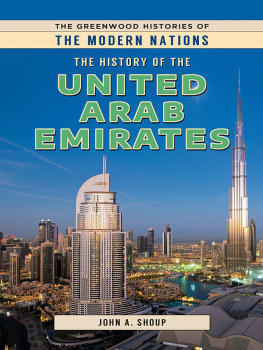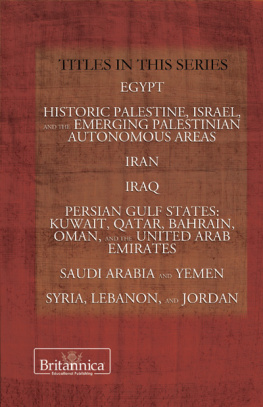THE HISTORY OF
THE UNITED ARAB
EMIRATES
THE HISTORY OF
THE UNITED ARAB
EMIRATES
John A. Shoup
The Greenwood Histories of the Modern Nations
Frank W. Thackeray and John E. Findling, Series Editors

Copyright 2022 by ABC-CLIO, LLC
All rights reserved. No part of this publication may be reproduced, stored in a retrieval system, or transmitted, in any form or by any means, electronic, mechanical, photocopying, recording, or otherwise, except for the inclusion of brief quotations in a review, without prior permission in writing from the publisher.
Library of Congress Cataloging-in-Publication Data
Names: Shoup, John A., author.
Title: The history of the United Arab Emirates / John A. Shoup.
Description: Santa Barbara, California : Greenwood, An Imprint of ABC-CLIO, LLC [2022] | Series: The Greenwood histories of the modern nations | Includes bibliographical references and index.
Identifiers: LCCN 2020058577 (print) | LCCN 2020058578 (ebook) | ISBN 9781440870439 (hardcover) | ISBN 9781440870446 (ebook)
Subjects: LCSH: United Arab EmiratesHistory.
Classification: LCC DS247.T85 S56 2021 (print) | LCC DS247.T85 (ebook) | DDC 953.57dc23
LC record available at https://lccn.loc.gov/2020058577
LC ebook record available at https://lccn.loc.gov/2020058578
ISBN: 978-1-4408-7043-9 (print)
978-1-4408-7044-6 (ebook)
262524232212345
This book is also available as an eBook.
Greenwood
An Imprint of ABC-CLIO, LLC
ABC-CLIO, LLC
147 Castilian Drive
Santa Barbara, California 93117
www.abc-clio.com
This book is printed on acid-free paper 
Manufactured in the United States of America
Contents
The Greenwood Histories of the Modern Nations series is intended to provide students and interested laypeople with up-to-date, concise, and analytical histories of many of the nations of the contemporary world. Not since the 1960s has there been a systematic attempt to publish a series of national histories, and, as series editors, we believe that this series will prove to be a valuable contribution to our understanding of other countries in our increasingly interdependent world.
At the end of the 1960s, the Cold War was an accepted reality of global politics. The process of decolonization was still in progress, the idea of a unified Europe with a single currency was unheard of, the United States was mired in a war in Vietnam, and the economic boom in Asia was still years in the future. Richard Nixon was president of the United States, Mao Tse-tung (not yet Mao Zedong) ruled China, Leonid Brezhnev guided the Soviet Union, and Harold Wilson was prime minister of the United Kingdom. Authoritarian dictators still controlled most of Latin America, the Middle East was reeling in the wake of the Six-Day War, and Shah Mohammad Reza Pahlavi was at the height of his power in Iran.
Since then, the Cold War has ended, the Soviet Union has vanished, leaving fifteen independent republics in its wake, the advent of the computer age has radically transformed global communications, the rising demand for oil makes the Middle East still a dangerous flash-point, and the rise of new economic powers like the Peoples Republic of China and India threatens to bring about a new world order. All these developments have had a dramatic impact on the recent history of every nation of the world.
For this series, which was launched in 1998, we first selected nations whose political, economic, and sociocultural affairs marked them as among the most important of our time. For each nation, we found an author who was recognized as a specialist in the history of that nation. These authors worked cooperatively with us and with Greenwood Press to produce volumes that reflected current research on their nations and that are interesting and informative to their readers. In the first decade of the series, close to fifty volumes were published, and some have now moved into second editions.
The success of the series has encouraged us to broaden our scope to include additional nations, whose histories have had significant effects on their regions, if not on the entire world. In addition, geopolitical changes have elevated other nations into positions of greater importance in world affairs, and so, we have chosen to include them in this series as well. The importance of a series such as this cannot be underestimated. As a superpower whose influence is felt all over the world, the United States can claim a special relationship with almost every other nation. Yet many Americans know very little about the histories of nations with which the United States relates. How did they get to be the way they are? What kind of political systems evolved there? What kind of influence do they have on their own regions? What are the dominant political, religious, and cultural forces that move their leaders? These and many other questions are answered in the volumes of this series.
The authors who contribute to this series write comprehensive histories of their nations, dating back, in some instances, to prehistoric times. Each of them, however, has devoted a significant portion of their book to events of the past forty years because the modern era has contributed the most to contemporary issues that have an impact on U.S. policy. Authors make every effort to be as up-to-date as possible so that readers can benefit from discussion and analysis of recent events.
In addition to the historical narrative, each volume contains an introductory chapter giving an overview of that countrys geography, political institutions, economic structure, and cultural attributes. This is meant to give readers a snapshot of the nation as it exists in the contemporary world. Each history also includes supplementary information following the narrative, which may include a timeline that represents a succinct chronology of the nations historical evolution, biographical sketches of the nations most important historical figures, and a glossary of important terms or concepts that are usually expressed in a foreign language. Finally, each author prepares a comprehensive bibliography for readers who wish to pursue the subject further.
Readers of these volumes will find them fascinating and well written. More importantly, they will come away with a better understanding of the contemporary world and the nations that comprise it. As series editors, we hope that this series will contribute to a heightened sense of global understanding as we move through the early years of the twenty-first century.
Frank W. Thackeray and John E. Findling
Indiana University Southeast
The United Arab Emirates (U.A.E.) emerged as an independent country on December 2, 1971, first as a union of six emirates, and then, on February 10, 1972, the union brought in the seventh emirate. Before that, two other gulf states were scheduled to join the union, but both opted out to form their own countries: Bahrain and Qatar. They became independent and recognized entities earlier in 1971.
The United Arab Emirates was formed from the sheikdoms that made up the very dry, infertile, underpopulated region of the Persian Gulf. Due to the lack of permanent water supply, before oil, the population was small and basically lived in huts made of palm wood and fronds called barasti or arish in Arabic. The few permanent buildings were forts that also served as the homes of the ruling elite and mosques. When the United Arab Emirates began to export oil, things drastically changed, and a rush toward construction began. In 1971, there were few permanent buildings in most of the towns in the emirates, but in just ten years time, these towns were transformed into important cities.











